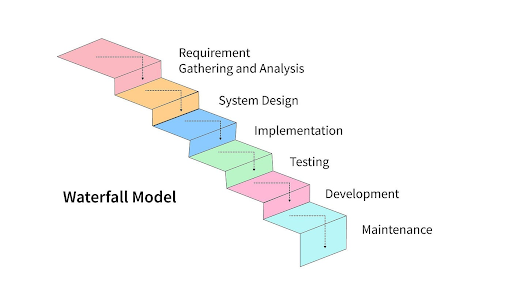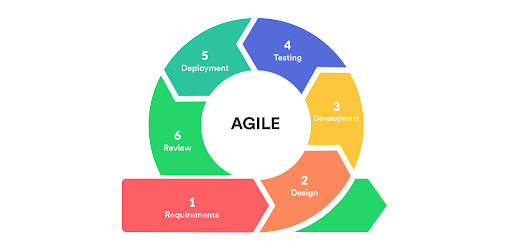
What Are the Best Practices in Agile Software Development?
By SOLTECH
If you have a software idea and have been talking to software development companies and firms, you have probably run across the word Agile and are wondering what all the hype is about.
Simply put, Agile is a framework of practices for adaptive, iterative software development. If you find yourself asking, “What do I actually need to know about Agile?” here is your answer. In this blog, we’ll cover everything from the methodology’s origins to Agile best practices.
 The Traditional Waterfall Approach
The Traditional Waterfall Approach
Before we move straight into Agile best practices, let’s first touch on the history of software development and the methodology that Agile is opposing.
Prior to Agile methodology steps, software was developed in large phases—an approach known as Waterfall. First, you would gather your software requirements and perform the analysis. Then, you would design the application, producing detailed documentation.
Once the documentation was ready, it would be handed to the developers to code. Finally, after coding was done, the entire application would be tested and presented to the software owners as a finished product. So, what was the issue? What started to push more people towards the Agile methodology steps?
Well, a few of the prevailing problems with the Waterfall approach included:
- It is hard to think through an entire software design on paper. When a business starts using the software, better ideas emerge but the software design is already solidified. Waterfall doesn’t allow for intermediate stages of feedback.
- The waterfall process can take months or years to complete, and there isn’t an opportunity to change the software if the needs of the business change during this time.
- Any vagueness in the requirements or assumptions made by the development team is not caught until the product is done, making it expensive to fix.

Why Agile Best Practices Are Different
The idea of Agile is stated in its name. Rather than being long, formal, and inflexible, the Agile software development methodology can produce results faster. Agile’s priorities include nimbleness from the start.
There is less effort spent on upfront requirements gathering and design. By incorporating Agile best practices, development teams spend more effort on crafting the most important features first, getting feedback as soon as possible and adjusting along the way.

*Agile Methodology Steps Highlighted by Medium
When incorporating an Agile approach, features are itemized based on the needs of the user. For every task that the user needs to accomplish using the software, a user story is written. For example, a user story could be, “As an administrative user, I want to be able to reset the passwords of all the users on my system.”
Through the Agile methodology steps, work is then broken down into short “sprints”. For each sprint, you will prioritize the user stories, and the team will develop and test them, typically in a 2-week timeframe.
The development will then be shown to you. Based on your feedback, you repeat the prioritization, development, and test cycle until the finished software product is delivered.
Where Agile Best Practices Come In
As someone who is looking to build software, it’s important to note that you don’t need to know all of the ins and outs of Agile and Scrum. Software teams can get hung up on the methodology or the technology they use rather than paying attention to what matters most: delivering the product you want in a reasonable budget and timeframe. Pro tip: Never lose sight of your software project’s scope.
What you do need to know when choosing a software team, regardless of whether they follow Agile priorities or not, is if they:
- Deliver demos of the code to you as soon as possible and frequently thereafter.
- Provide the flexibility to change requirements and design as the project progresses.
- Allow you to prioritize the development of features.
- Provide frequent budget updates to help you control costs and make sure the necessary features are delivered with the money you have allocated.
Following the Agile software development methodology does not necessarily guarantee better software. Incorporating Agile best practices doesn’t guarantee success; Agile projects can encounter challenges similar to those in Waterfall.
The success of your project depends on how well your team understands your requirements, knows how to use technology to build quality software, takes in your input, is flexible to your changing needs, and can execute using a reliable process. While following best practices for Agile can make a big difference, your team will still need to put in work beforehand to best understand the goals.
Resource: The 5 Pillars Of A Successful Software Project
We want to help every software project begin on solid ground. In The 5 Pillars of A Successful Software Project, we share the five essential ingredients of every software project.
Click the link here to grab your copy and share it with your team! You can also contact our team if you have any questions about Agile best practices and how we can help your team build the best software.
Agile Software Development FAQs
What are Agile best practices?
The best practices of the Agile software development methodology include breaking work down into shorter “sprints”, which can help your team efficiently update software in real time.
Why use Agile?
If your team is looking to create software in a faster manner, the Agile software development methodology could be better than the Waterfall approach.
How should I implement Agile in software development?
Agile software development is implemented through ongoing cycles of short ‘sprints,’ typically lasting 2-4 weeks. Each sprint focuses on prioritized user stories, allowing for development, testing, and feedback at regular intervals. This iterative approach ensures continuous improvement and adaptability throughout the project.

